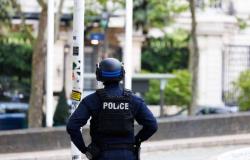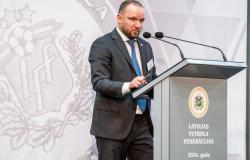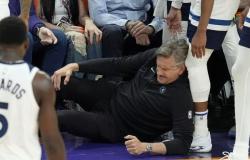Illustrative image.
Photo. Vadim Savitskiy/Russian Defense Ministry Press Service via AP
In the short and medium term, Vladimir Putin’s regime will continue to maintain confrontational relations with the West, including, if necessary, threatening the escalation of the conflict, including the use of nuclear weapons, however, Russia’s readiness to start an open military confrontation with a stronger opponent is unlikely, the Constitutional Protection Office (SAB) assessed in its latest article ).
“Pretty, pretty Saharan dust…” Netizens debate what actually caused the dust on cars
TV24
Saeima MP: Jānis Patmalnieks deserves a pennant for the end of Kariņš’s political career
A cocktail
PHOTO. Royal expert reveals unheard and intriguing details of Prince Harry’s planned UK visit
Read other posts
Russia’s relations with Western countries have gradually deteriorated since the annexation of Crimea in 2014 and the start of hostilities in the eastern regions of Ukraine. In addition, Russia has historically perceived NATO as a threat, the office emphasizes.
Since the beginning of the large-scale invasion of Ukraine, anti-NATO statements have become part of the daily rhetoric of Russian officials. Some of the statements also include direct threats to the NATO alliance and its member states.
How Russia will shape its future relations with NATO can be influenced by a number of factors – Russia’s ability to renew its military forces and military industry; Russia’s economic situation and political considerations. Further development of NATO’s defense and deterrence capabilities is equally important.
According to publicly available information, since the start of the invasion, Russia has lost more than 315,000 soldiers, including dead and wounded. Ukrainian sources put Russian losses even higher at over 400,000 military personnel.
The significant losses of the Russian army are evidenced by the need for mobilization. In order to maintain the combat capabilities of the army, in September 2022, Putin signed a decree announcing partial mobilization. Soldiers were also attracted by representatives of “private” military companies fighting in Ukraine, for example, “Wagner Group” recruited soldiers in Russian prisons, according to SAB.
Mobilization in Russia continues in a covert manner, because this is the only way to compensate for the loss of manpower in Ukraine. With the continuation of the war and Russian losses, repeated “open” mobilization is not excluded. In announcing it, Russia’s leading elite will be guided by the situation at the front and the common mood in society.
SAB emphasizes that along with the loss of soldiers since the beginning of the war, Ukrainian forces have managed to destroy a significant amount of Russian armored vehicles, as well as aircraft and ships. The biggest losses of soldiers and equipment can be observed directly in the ground forces, while the Russian Navy and Air Force maintain relatively high combat capabilities.
As the Russian invasion of Ukraine drags on, the importance of the military-industrial complex in maintaining the combat capabilities of the Russian forces is increasing. Russia has been able to adapt its production to war needs in the short term. As hostilities in Ukraine continue, Russia’s ability to renew and replenish its arsenal is expected to diminish.
Russia’s military-industrial complex continues to face workforce problems, especially highly skilled workforce, as well as challenges to motivate employees to continue working in high-intensity conditions.
Production capacities can be negatively affected by the wear and tear of the infrastructure used in production and the limited opportunities to access the components needed to restore the infrastructure’s operation. The redirection of the resources of the military-industrial complex to maintain the combat capabilities of the Russian army in Ukraine further limits the development and implementation of new military technologies, which in the medium term may increase the technological backwardness of Russian-made armaments from Western or Chinese-made armaments, SAB said.
The war in Ukraine and the resulting geopolitical changes in Europe have made it necessary for Russia to evaluate the suitability of the existing armed forces model. Already at the end of 2022, Russian Defense Minister Sergey Shoigu issued a statement on the reform of the Russian Armed Forces, aimed at improving the command and control of the military forces and increasing the number of armed forces units and personnel to 1.5 million in 2026.
To the west, as part of the reform, on February 26, 2024, the military districts of Moscow and Leningrad, which had been united in the Western military district since 2010, were restored.
Taking into account the hostilities in Ukraine and the losses of Russian soldiers and equipment, it can be predicted with high reliability that Russia will face difficulties until 2026 to make actual changes in its armed forces and to fully form and equip existing and newly created units. However, this will not prevent Russia from creating an image of the progress of the reform of the armed forces in its public statements, SAB concluded.
Russian senior officials regularly come up with threats to use nuclear weapons, including linking them to the course of hostilities in Ukraine and the support provided by Western countries.
The threat of using nuclear weapons is more intensively used by Russian officials in cases when the Ukrainian army has succeeded in achieving success on the front, or when the political discussion in Western countries about providing new support to Ukraine becomes more active.
With the help of aggressive nuclear rhetoric, Russia also seeks to raise the level of anxiety in the societies of Western countries. The use of nuclear weapons would certainly provoke a negative international reaction even from countries that are currently neutral or friendly to Russia, such as China. The use of nuclear weapons would also further consolidate the West and could facilitate the delivery of new types of weapons systems to Ukraine.
Russia’s war in Ukraine and related sanctions have adversely affected Russia’s economy and access to foreign capital. At the same time, Russia continues to use the instruments available to the state to promote economic stability.
Currently, one of the pillars of the Russian economy is its military-industrial complex, as well as the still high revenues from the international trade of hydrocarbons, including circumventing sanctions and trade restrictions. As the war in Ukraine continues, Russia will continue to adapt its economy to the needs of the war, which on the one hand will allow the maintenance of hostilities and the combat capabilities of the Russian army, but in the medium term will reduce or even stop the growth of the Russian economy.
The Russian invasion of Ukraine was planned as a quick, victorious war, where Ukrainian resistance would be overcome in a short time, not a conflict lasting more than two years, for which Russia was not ready either militarily or economically. Taking into account the course of the war, Russia has to reassess the possible course of potential future conflicts and assess the country’s ability to engage in such a conflict and win.
The primary interest of the Putin-led regime is to strengthen or maintain its position of power. Russia’s domestic and foreign policy actions are planned based on the above-mentioned primary interest, respectively, making actions that can directly threaten the stability of the regime less possible.

Vladimir Putin.
Photo: AFP/SCANPIX
On the one hand, the regime can use the conflict situation for further mobilization of society, but on the other hand, in case of losses, the risks for the regime to maintain power increase.
The unsuccessful course of the war in Ukraine, including Ukraine’s ability to resist much larger Russian forces, makes it necessary for the Putin regime to reassess Russia’s ability to conduct such clashes and achieve the planned result. In the SAB’s assessment, in the short and medium term, Russia’s readiness to start an open conventional military confrontation with a stronger opponent like NATO is unlikely.
Maintaining an external threat is one of the most common tools of public mobilization in authoritarian countries, and has long been used by the Russian political regime.
NATO has also been described in Russia for a long time as an organization with an aggressive attitude towards Russia, and in the medium term it is more profitable for Russia to maintain the image of NATO as an aggressor, thus continuing to mobilize public support for the political regime. Russian officials will continue to spread messages about NATO as a threat to Russia and the need to continue a confrontational policy on the part of Russia in public communication with varying intensity.
Russia’s relations with NATO and the possibility of confrontation should also be evaluated in the context of other regional and global political processes. Regionally, Russia’s invasion of Ukraine has reduced Russia’s influence in regions close to it, such as the South Caucasus or Central Asian countries.
It is expected that an open confrontation with NATO will further force the countries of the region to look for alternative directions of cooperation, thereby reducing Russia’s role in the region. Russia’s invasion of Ukraine has increased Russia’s dependence on China. As China’s economy continues to grow, in a situation where Russia’s economy is stagnating, there is a high probability that Russia will have to pay more strategic attention to China and how to limit its growing dependence on it.
In invading Ukraine, the Putin regime had relied on the lack of unity in the West and the differing positions of Western countries on relations with Russia. However, the war has fostered Western unity and willingness to take steps to curb Russian aggression.
In addition, the Russian invasion has contributed to the review of the defense policy of Western countries, especially European countries, with most countries making decisions on increasing their defense capabilities in the coming years.
Since the beginning of the invasion, NATO has undertaken a series of important practical actions to strengthen deterrence and defense capabilities, such as the development of new regional plans. An important event in strengthening the alliance’s joint capabilities, especially in the Baltic Sea region, is the accession of Finland and Sweden to the alliance.

Photo: REUTERS/SCANPIX
In the conclusion section, SAB stated that the course of the Russian invasion of Ukraine has raised questions about the further scenarios of Russia’s actions, including possible open confrontation with Western countries, including NATO members.
Announcements about reforms of the Russian armed forces, aimed at strengthening the military presence in the western regions of the country, regular threats of using nuclear weapons issued by Russian officials, as well as the generally confrontational tone maintained by Russia, give the impression of the inevitability of an open military confrontation.
A review of the actual situation in Russia, on the other hand, shows several factors that do not confirm what is expressed in Russia’s rhetoric. First of all, the primary task of the Russian defense sector is the war in Ukraine, to which the majority of the armed forces, the resources of the military-industrial complex and the armament reserves accumulated over the years are directed. Russia will need time to restore the equipment lost in the war, train soldiers, as well as restore reserves, according to SAB.
These actions will have to be carried out in conditions where the Russian economy will continue to face challenges and the country will have to evaluate which needs to direct its limited resources to.
Although Putin’s regime remains stable, the war in Ukraine has increased pressure on the regime, including creating new types of risks, as demonstrated by the “Evgeny Prigozhin Rebellion” in June 2023.
The primary goal of the Putin regime is to maintain its power, and although a confrontational policy with the West promotes public mobilization and support for the regime, a potential escalation or open military conflict can have unpredictable consequences. In the SAB’s assessment, in the short and medium term, Putin’s regime will continue to maintain confrontational relations with Western countries and NATO, including, if necessary, threatening the escalation of the conflict, including the use of nuclear weapons.
It is likely that Russia will continue to use hybrid methods of various nature against NATO members, including information and influence operations, as well as cyber attacks. At the same time, the probability of an open conventional military confrontation with Russia remains low, SAB concluded.
Themes
Tags: SAB Russia continue hybrid methods nature NATO members
-





